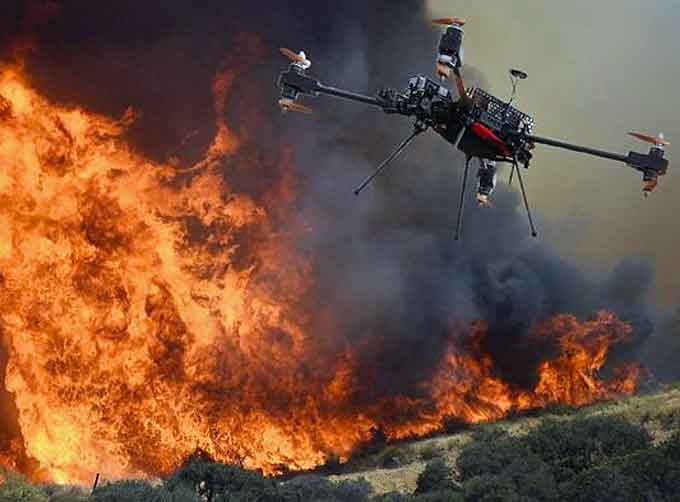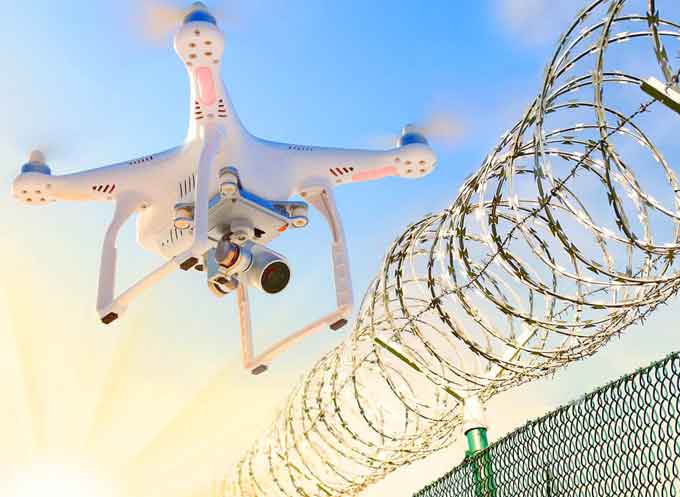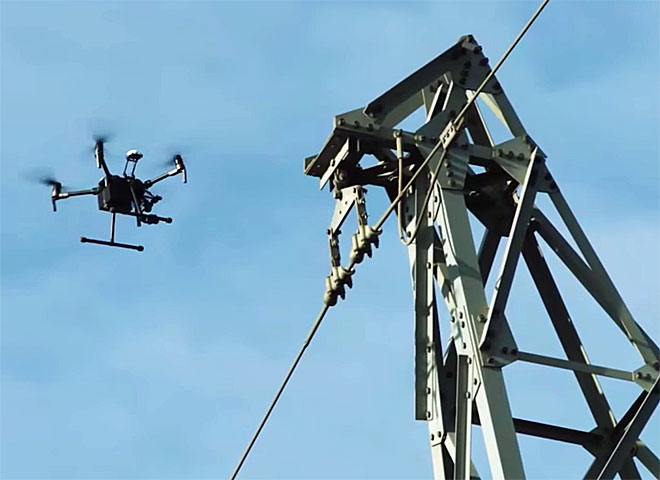
Guest Editorial by Charles Werner, Public Safety Advisor & Chair, National Council on Public Safety UAS (NCPSU)
Over the past year, unmanned aircraft systems (UAS)—aka drones—have demonstrated their value to public safety organizations worldwide through their dramatic use during the recent hurricanes, earthquakes and wildfires.
Small UAS (sUAS—under 55 lbs.) are now available from many commercial outlets, are relatively inexpensive, fly up to 100 mph and are very hard to detect.
Unfortunately, their expanded use and abilities has also created new threats.
Dangers above

U.S. Department of Justice Senior Law Enforcement Program Manager Michael O’Shea categorized the UAS threats as being “careless, clueless or criminal.”
The less serious form of threats from drones are often unintentional (careless or clueless), as people unknowingly fly into restricted airspace simply due to their lack of knowledge or awareness.
UAS have crashed into passenger aircraft (Canada, 2017), crashed into a military Black Hawk helicopter (New York, 2017), disrupted airspace around airports (ongoing), crashed into sports stadiums (Kentucky, 2015), crashed into a crowd of people (Japan, 2017), crashed on the White House lawn (2015), flew near a dignitary (Germany’s Chancellor Angela Merkel, 2013) and repeatedly interfered with wildland firefighting operations (California, ongoing).
(A black hawk helicopter was damaged by a drone flown by an unknown person in New York. Courtesy of ABC News and YouTube. Posted on Sep 24, 2017.)
The nefarious and malicious (criminal) use of drones has been documented in various places around the world and are increasing steadily.
The more dangerous, intentional and illegal uses of drones have been documented as dropping guns/drugs into prisons (multiple examples), drug cartels carrying explosives (Mexico, 2017), assisting with prison escape (South Carolina, 2017), international transportation of illegal drugs (Australia, 2017), and counter-surveillance (Australia, 2017).
The list of examples has become too long to list all of them.
Further, the Department of Defense (DoD) has reported that ISIS and other terrorist groups have begun to use UAS against U.S. forces.
(Fox News reports on efforts to protect against these malicious drone tactics. Courtesy of Fox News and YouTube. Posted on Apr 5, 2017.)
UAS are being used by our enemies for reconnaissance and as weapons by carrying explosives.
This intelligence has been shared with law enforcement and public safety agencies to increase situational awareness of potential use within the U.S. homeland.

Drones are also being modified to have a “catch and release” capability, which could be used to transport and deliver drugs, guns, explosives, acid, biological/chemical agents and virtually anything that can be carried by the UAS.
Crop-dusting drones could also be used to spray weaponized toxins.
As the technology continues to advance for both the unmanned aerial vehicles and payloads, the threat will continue to evolve and increase.
The validation and concern about the potential threat of drones became very real when a drone was used to drop anti-media leaflets over two National Football League (NFL) games in California (San Francisco and Oakland) on Nov. 26, 2017.
(Tracy Mapes was arrested after illegally flying a drone over both the Raiders and 49ers games. Courtesy of KPIX CBS SF Bay Area and YouTube. Posted on Nov 27, 2017.)
This is a wake-up call as to the threat that this presents for all large venues where tens of thousands of people are in attendance.
This threat includes college and professional open-air sports arenas as well as all open-air entertainment venues, such as outdoor theaters, amusement parks, etc.

This specific event demonstrated that a person who was upset could use the drone technology to drop something over NFL fans.Fortunately, this was just leaflets and caused no harm.
But this leaves the lingering and very real danger that anyone who wishes to cause harm to others or create chaos/panic can easily purchase a drone from a local store and use it in a number of dangerous capacities.
Many public safety colleagues from all disciplines have expressed their concerns, as any such event would create the possibility of mass casualties, a mammoth hazmat decontamination or other major situation requiring a significant number of resources.
The UAS threat also includes the possible spying or attack on critical infrastructure, nuclear power plants, chemical plants, utilities and airports.
(FBI Director Christopher Wray has warned US Congress on Wednesday of imminent terrorist drone attacks on the US soil. Courtesy of C-Span, Chuck Ross and YouTube. Posted on Sep 27, 2017.)
Counter-tech options and restrictions
There is a clear and present danger from the nefarious use of drones that continues to evolve.
These very real examples of both intentional and unintentional threats from UAS demand the need for a very deliberate and urgent research and development of counter-UAS (C-UAS) technologies that can effectively detect, identify and mitigate.
Presently, research and development (R&D) of C-UAS in the United States is restricted primarily to the DoD and is outlined in the National Defense Authorization Act (NDAA) of 2017, which allows DoD to use and conduct C-UAS research and development on military bases.

While this helps to advance C-UAS, it does not include other localities or venues.
The inclusion of other localities, venues and organizations will be critical to the protection of civilian facilities mentioned previously.
The types of C-UAS are divided into two main categories:
-
Passive detection/identification, and
-
Active mitigation
Passive detection equipment can be used without restriction. These technologies include radio frequency receivers, audio sensors, visual sensors and radar.
This technology does not impact the flight of the UAS and are allowed in the United States.
Active mitigation technologies/strategies include radio frequency-jammers, deceptive GPS spoofing, protocol manipulation (hacking), sonic- or sound-blasting, electromagnetic pulse, lasers, high directed energy microwave, net shooting devices, counter-drones, trained birds of prey (eagles and falcons) and shotgun shells designed for UAS.
(Learn More about C-UAS current technologies. Hear from Logan Harris, SpotterRF, CEO as he introduces the A3000 counter-drone radar and C-UAS Mobile, a man-packable counter-UAS radar kit. SpotterRF is a Two-Time Winner in the Annual ‘ASTORS’ Homeland Security Awards Program for Best UAV Perimeter Protection Solution. Courtesy of SpotterRF and YouTube. Posted on Sep 29, 2017.)
Active C-UAS is restricted within the United States, except for use on military installations and special situations that threaten national security.
One reason some of the C-UAS technology create complex situations are because they may use a jamming technology that may jam other radio signals and/or devices.
Jamming could also cause a UAS to return to home, but the home location could also be programmed as the target location.
Also, the method of mitigation must consider what happens to the aircraft after mitigation (i.e., is the aircraft controlled and landed safely or if mitigation causes the drone to crash, what will be the impact, etc.).
C-UAS restrictions are in place by a combination of FAA and FCC regulations and federal laws.
(Learn More. Dec 21, 2016 was the one year anniversary of the FAA’s drone registry. During that first year more than 600,000 people have registered their drones online and received safety information. We now have more than twice as many drones as manned aircraft in our nation’s airspace. Courtesy of the FAA and YouTube. Posted on Dec 21, 2016)
There are approximately 16 regulations or laws that prevent the use and research of C-UAS technology that can mitigate a UAS in flight.
For this R&D to move forward, it will require a concerted effort of federal agencies and Congress to address these laws and regulations.
Changes to regulations and laws must address the authorized use and limit the liability when used. The very fact that UAS is defined as an aircraft eliminates almost every means of mitigation.
If the regulations and laws are not addressed, C-UAS technology that is proven to be operationally effective will not be able to be implemented.
In sum
The need for C-UAS has been clearly identified.
The need for C-UAS mitigation R&D is urgently needed to do the necessary testing to ensure an effective mitigation of the UAS threat while also ensuring the safety of people in proximity of such a mitigation.
Different circumstances are likely to require a combination of C-UAS solutions. Additionally, there will be training needed for those who will implement C-UAS technology.
(Learn More. This briefing examines the driver behind the growth in the C-UAS market and the range and type of C-UAS capabilities being developed. Includes: Examples from C-UAS tests, Kinetic vs Non-kinetic systems, Commercial UAVs as a growing security threat. Courtesy of Jane’s by IHS Markit and YouTube. Posted on Apr 26, 2017.)
For UAS to continue to thrive and evolve in the United States, it will require having an effective C-UAS strategy.
Failure to develop such a strategy soon presents an unacceptable danger to our citizens.
Should such a drone attack occur at one or more of these large venues, it may result in mass casualties and a loss of confidence in personal safety when attending such venues.
This would have a dramatic financial impact on organizations, venues, communities and the nation.
Now compound this threat with a swarm of drones—the time to act is now!
(Christopher Hawkins examines the use of weaponized UAVs in the Middle East, and the implication for security in the West. Courtesy of Jane’s by IHS Markit and YouTube.Posted on May 9, 2017.)
About the Author

Charles Werner, is a 43-year veteran of public safety. He is fire chief emeritus of the Charlottesville, VA, Fire Department.
He recently served as senior advisor and acting deputy state coordinator to the Virginia Department of Emergency Management, and presently serves on the Board of the National Alliance for Public Safety GIS Foundation, the International Public Safety Association Technology Council, the Association of American Railroads Public Safety Rail Advisory Committee. Werner is chairman of the National Council on Public Safety UAS, chairman of the International Public Safety Association UAS Committee, and Public Safety UAS Advisor to the National Center of Security and Preparedness-University of Albany.
SpotterRF Wins Again in the 2018 ‘ASTORS’ Homeland Security Awards Program
AST focuses on Homeland Security and Public Safety Breaking News, the Newest Initiatives and Hottest Technologies in Physical & IT Security, essential to meeting today’s growing security challenges.
 The 2018 ‘ASTORS’ Homeland Security Awards Program, is organized to recognize the most distinguished vendors of Physical, IT, Port Security, Law Enforcement, Border Security, First Responders, (Fire, EMT, Military, Support Services Vets, SBA, Medical Tech) as well as the Federal, State, County and Municipal Government Agencies – to acknowledge their outstanding efforts to ‘Keep our Nation Secure, One City at a Time.
The 2018 ‘ASTORS’ Homeland Security Awards Program, is organized to recognize the most distinguished vendors of Physical, IT, Port Security, Law Enforcement, Border Security, First Responders, (Fire, EMT, Military, Support Services Vets, SBA, Medical Tech) as well as the Federal, State, County and Municipal Government Agencies – to acknowledge their outstanding efforts to ‘Keep our Nation Secure, One City at a Time.
To Learn More about the ‘ASTORS’ Homeland Security Awards Program, see 2017 ‘ASTORS’ Homeland Security Award Winners Honored at ISC East.

Over 100 distinguished guests from National, State and Local Governments, and Industry Leading Corporate Executives from companies allied to Government, gathered from across North America and the Middle East to be honored from disciplines across the Security Industry in their respective fields which included representatives from:
 The Department of Homeland Security (DHS) Science and Technology Directorate (S&T)
The Department of Homeland Security (DHS) Science and Technology Directorate (S&T)- U.S. Customs and Border Protection
- The Department of Justice
- The Security Exchange Commission
- State and Municipal Law Enforcement Agencies
- The Royal Canadian Mounted Police
- Leaders in Private Security
American Security Today will be holding the 2018 ‘ASTORS’ Awards Presentation Luncheon to honor Nominees, Finalists and Winners on November 14, 2018 at ISC East 2018 in New York City.
Nominations are now being accepted for the 2018 ‘ASTORS’ Homeland Security Awards at https://americansecuritytoday.com/ast-awards/.
To learn more about SpotterRF’s wide range of offerings, please visit the companies website at https://spotterrf.com.
For ‘ASTORS’ Sponsorship Opportunities and More Information on the AST 2018 ‘ASTORS’ Homeland Security Awards Program, please contact Michael Madsen, AST Publisher at: mmadsen@americansecuritytoday.com or call 732.233.8119 (mobile) or 646-450-6027 (office).
Learn More…
FBI Warns of Imminent Terror Drone Attacks on US Soil (Multi-Video)
















